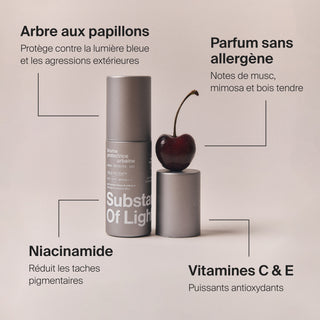Introduction
Every day, our skin is confronted with environmental aggressions. Among these factors, High Visible Energy (HEV) including blue light stands out by degrading skin texture, wrinkles, hyperpigmentation , and even increasing the risk of skin cancer in fair phototypes.
Do you know the difference between blue light from the sun and blue light from computer screens? What is their relevance and what are their impacts on the skin? How should we approach them on a daily basis to better protect our skin? Deciphering blue light and its impact on skin health.
Blue light - High Visible Energy (HEV)
Blue light in the digital age:
Blue light, also known as High Energy Visible (HEV) light, has become established with the increasing use of digital devices. However, the majority of HEV comes from the sun (constituting 39% of solar radiation compared to 7% for UV and 54% for infrared).
However, recent studies have shown that blue light from computer and smartphone screens contributes to damaging skin cells. For example, 64 days spent in front of a digital screen (i.e. 2 months at 8 hours/day) correspond to one hour of exposure to the sun without protection , in our latitudes in the middle of summer. It is therefore essential to protect yourself indoors and outdoors. blue light which can damage macromolecules, causing DNA damage, oxidative stress through lipid peroxidation, and dermal matrix degradation of collagen and elastin.
Effects on the skin
Hyperpigmentation:
Historically studied since the 1980s by Kollias and Baquer, recent research indicates that UVA1 and visible light induce pigmentation in melano-competent phototypes (phototypes > IV), and this pigmentation would be even darker and lasting. Protection of melanin becomes crucial with increasing wavelength. In dark phototypes, we must protect ourselves from visible blue light, a pigmentation factor induced by the production of melanin.
Skin aging:
Studies show that visible light, primarily blue light, contributes to skin aging by generating more than half of reactive oxygen species (ROS) in the skin. And according to some researchers, 25% of cellular damage is caused by blue light. The effects differ between light and dark phototypes, requiring appropriate protection. Among fair phototypes, we must protect ourselves from visible blue light, a factor in skin aging via free radicals and oxidative stress, and an increased risk of skin cancer.
Blue light protection
Understanding the devastating effects of blue light reinforces the call for preventative measures to maintain healthy skin across various modern light exposures. You should also be interested in the latest innovations in blue light protection.
Focus on organic (chemical) filters
To prevent or minimize damage from UV exposure, look for a broad-spectrum sunscreen , preferably with organic filters, that protects against both UVA, UVB, and HEV (blue light). Alternatively, iron oxide yellow protects melanocompetent subjects from visible light, reducing visible light transmission by 93-98%, but may not be aesthetically suitable for darker skin tones.
Don't forget that the damage is measured in the long term, hence the absolute necessity, in terms of public health, to protect ourselves from an early age and throughout life.
Modulation with antioxidants:
Antioxidants can effectively modulate some visible light, but their effectiveness may vary, particularly in pigmentary disorders.
Computer filters and anti-blue light glasses:
Optimize your protection against blue light by investing in filters integrated into computer screens or by adopting glasses equipped with protective lenses, thus guaranteeing reinforced defense against the harmful effects of blue light.
Conclusion
Blue light, high visible energy, constitutes a new skin enemy potentially more harmful than UVA and UVB, particularly for dark skin . With deeper penetration , it attacks all cellular constituents (lipids, proteins, DNA), requiring protection from a very young age. Long-term effects, particularly on fair skin, including skin aging and cancer mechanisms via the formation of toxic reactive oxygen species (ROS), underline the crucial importance of this protection. Blue light also impacts the pigmentation gene , aggravating certain dermatoses linked to melanin, especially on dark skin.
Pro tip: Iron oxides found in most facial makeup products help protect against HEVL, but makeup alone doesn't protect against UV rays. Apply your sunscreen before applying makeup or as the last step in your skincare routine over makeup .
TRUE FILTER™ Urban Protective Mist: the ideal protection against blue light.
TRUE FILTER™ 's patented technology provides extensive protection against damage caused by blue light (HEV), a major factor in skin aging. This unrivaled protection goes beyond traditional products considered "broad spectrum" or PA classified with a reduction in oxidative stress of almost 90%.
Explore the urban protective mist TRUE FILTER™ from Substance Of Light ® , a truly innovative breakthrough in daily protection against blue light.

Bibliography
- T. Mann, K. Eggers, F. Rippke, et al. “High‐energy visible light at ambient doses and intensities induces oxidative stress of skin—Protective effects of the antioxidant and Nrf2 inducer Licochalcone A in vitro and in vivo” Photodermatol Photoimmunol Photomed. 2020;36(2):135-144 https://onlinelibrary.wiley.com/doi/full/10.1111/phpp.12523
- BH Mahmoud, E. Ruvolo, CL Hexsel, HW Lim, et al., “Impact of Long-Wavelength UVA and Visible Light on Melanocompetent Skin”. Journal of Investigative Dermatology, Volume 30, Issue 8, August 2010 https://www.sciencedirect.com/science/article/pii/S0022202X15349307
- Zastrow L, Groth N, Klein F et al. The Missing Link – Light-Induced (280–1,600 nm) Free Radical Formation in Human Skin. Skin Pharmacology and Physiology 2009;22:31-44 https://pubmed.ncbi.nlm.nih.gov/19122479/
- Henry W. Lim, Indermeet Kohli Corinne Granger, Carles Trulla`s, Jaime Piquero-Casals, Mridvika Narda, Philippe Masson, Jean Krutmann, and Thierry Passeron https://pubmed.ncbi.nlm.nih.gov/34112516/
- https://fluxometer.com (Light intensity for an iPhone X: Blue light (weighted power): 8.14 μW/cm2/ 1h dose = 0.0293 J/cm2
- Journal of Investigative Dermatology (2010)130,259–269; doi:10.1038/jid.2009.194; published online August 13, 2009 https://pubmed.ncbi.nlm.nih.gov/19675580/
- Coats, Jahnna G., et al. “Blue Light Protection, Part I—Effects of Blue Light on the Skin.” Journal of Cosmetic Dermatology, vol. 20, no. 3, 2020, pp. 714–717., https://doi.org/10.1111/jocd.13837
Photography: Ben Hasset Photographer: Ben Hassett / Director: Celia Azoulay












